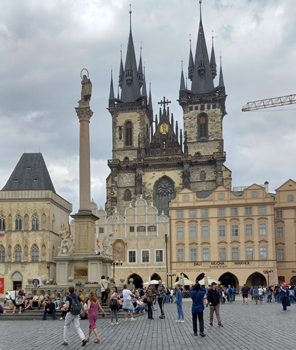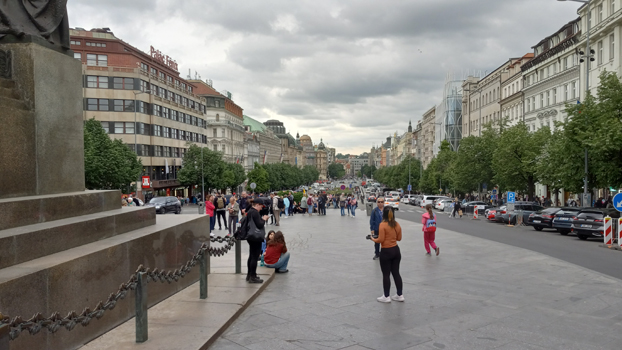 |
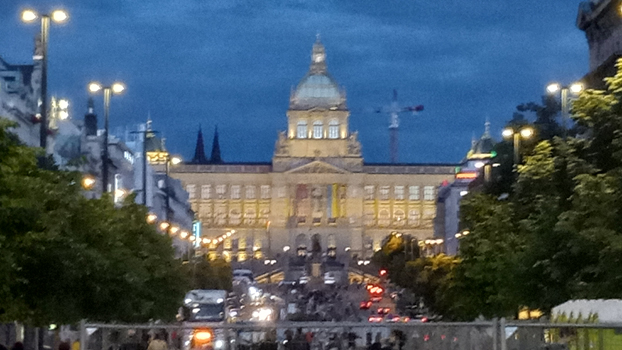 |
|
Wenceslas Square facing northwest |
Wenceslas Square facing southeast |
Stare Mesto is filled with electric trams, which are always well populated. People in Prague are constantly in motion,
and trams are their vehicle of choice. Many times, the tram will attach a second or third car. They pass continuously,
20 times an hour, which is undreamt-of convenience for an American. And for those over 65, they are all free, including
the Metro. Getting from the airport into the center only takes 35 minutes, with the 119 tram from the airport and the
Metro from Veleslavin straight to Mustek, at the top (northwestwest end) of Wenceslas Square, where we stayed. The
Uber-dominated airport cab service, for which there are Uber kiosks to place your order, something we had never heard of
before, costs about US $35 each way. We used public transit at some point most days.
The apartment building where we stayed , 699/30 Vodickova, is a mixed use, art nouveau gem of a miniature society.
Owned by the Havel family itself, it was built in 1878 and updated to art nouveau after the turn of the century. The
ground floor is a mall of remarkable stores. Lots of high end antiques and furnishings, a French tearoom, a French
cheese shop, an Indian restaurant, a vegan cafeteria, a live theatre, two cinemas (one a fan club/lounge), and even
a sports jersey store, a record album store, and a trading card store, all mixed in with intersecting hallways of the
five, six storey buildings that make up most of the block that was our building. There is a theater ticket store as well
as a lottery ticket store, the famous Lucerna cinema flanked by luxury cafes and featuring the famous David Czerny
sculpture of a larger than life-sized knight astride an upside down horse, hanging from the ceiling. There are art
galleries from cheap to beyond, bookstores, and not a single American store. It was wonderful explore. The next few
floors are offices, mostly medical and professional, including all kinds of labs and services mixed in with apartments.
When we were there, there was only one store that was unoccupied (which itself says a lot), and an Artic Bakehouse, one
of top three or four bakeries in town, was preparing to move in. Right across the street is Mysak, another of the top
bakeries, with its actual bakery up on the second floor, where they do takeout. To say the area was stimulating is to
say nothing at all. It is also within walking distance of absolutely everything you want to see in Stare Mesto. And that
is very much a lot.
The front doors of our building are huge, stained glass art nouveau, and the front wall has a huge mural from
that era. Ironwork art nouveau decorates the windows, doors and balconies. Our apartment was a sixth floor joy of
airy sunlight, with steep sloping windows from wall to wall on two sides. It being May, we got both sunrise and
sunset streaming in. It was comfortable/shabby; the owners had to move out when they had their first child (now two),
and never bothered to renovate for short term rentals. It is relaxed and homey as well as high ceilinged and spectacular.
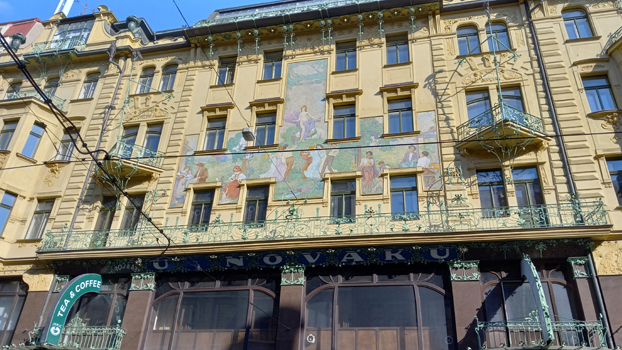 |
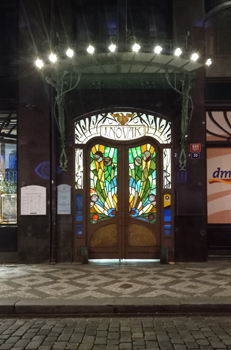 |
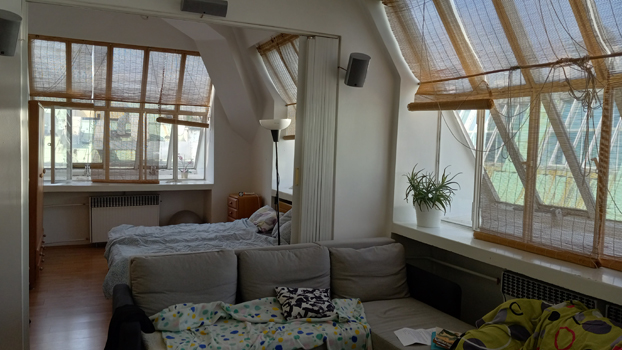 |
|
Vodickova apartment building |
Art Nouveau entrance |
Apartment 607 |
One of the touristy things I wanted to see was the Pater Noster elevator, in which a single person steps into a
constantly moving wooden cabinet, either up or down. You step out as it passes your floor, or you miss your floor.
It is a throwback to the 1920s, beautifully maintained, but not worth a special side trip for. Except unexpectedly,
it turned out to be right in our building, So we tried it. Very cool.
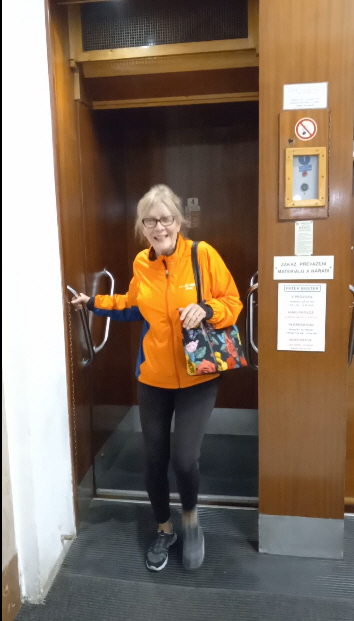 |
Pater Noster Elevator video |
Three blocks away is the famous Metamorphosis, also by David Czerny, who is an industry of attractive, humorous
public art all over Prague. It is a giant bust of Franz Kafka, made of 40 slices of shiny aluminum that
reflects the surrounding buildings differently all day and night. At the top of the hour, the slices start rotating
at different speeds and directions, creating different abstract designs, periodically reassembling as Kafka, facing
different directions. The show goes on for 15 minutes.
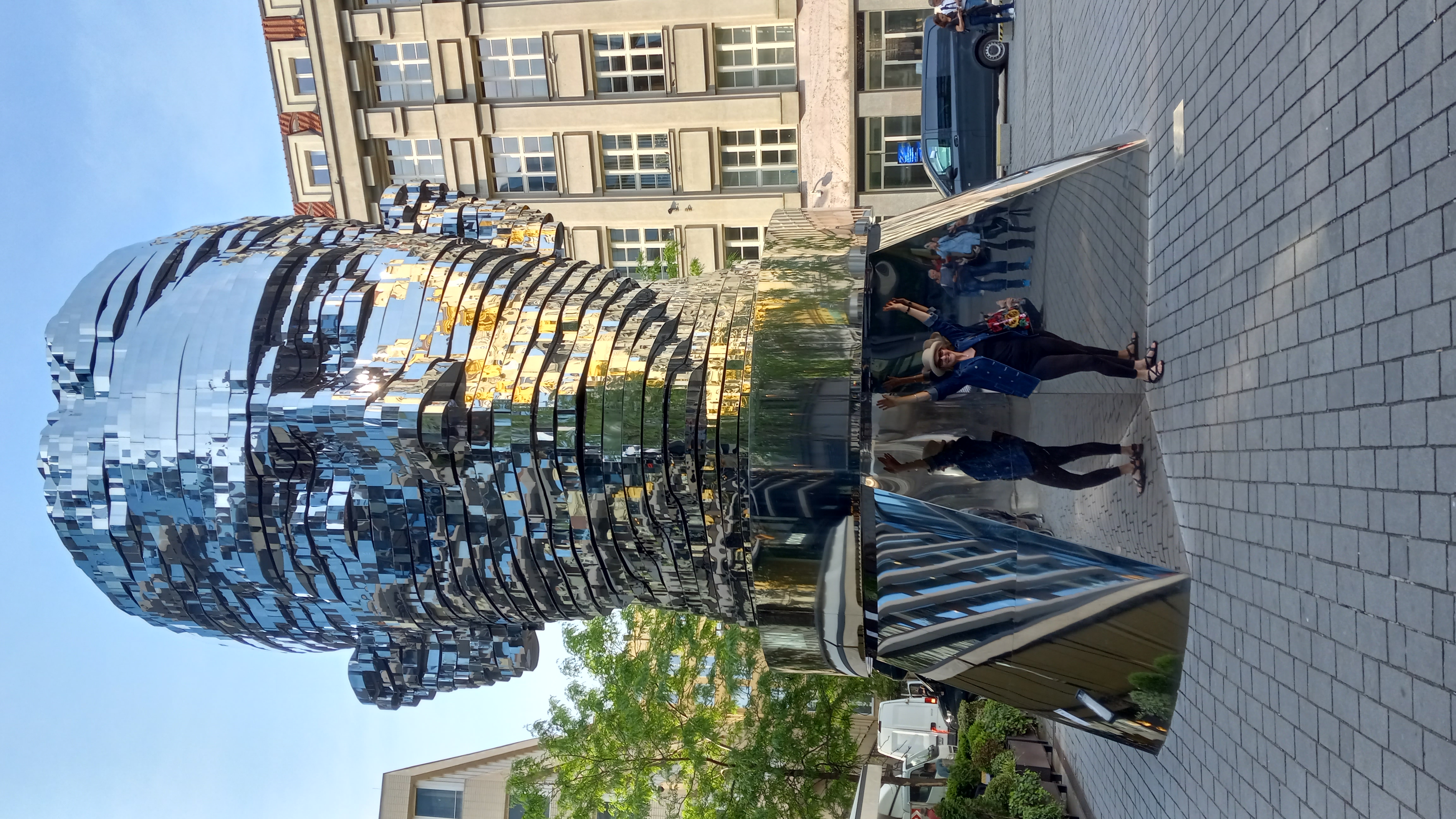
Franz Kafka Metamorphosis video
What to do all day for nine days was walk (Normally, I give a new city four days, but it was clear well in advance
that Prague merited nine or ten). There are so many sights and sites to see, there is never a worry about boredom.
The fairy tale architecture of the 17 and 1800s is stunning, and beautifully maintained. We were not pleased to see
all the McDonalds and Starbucks everywhere (except our sanctuary building), but most of what we saw was locally owned.
A little research sent us to a tiny alley off the beaten track, where a vegan restaurant had inventive, full course meals
like we’ve never experienced. At Lehka Hlava (Clear Head), every dining room is decorated differently. Ours had a large, standard
country landscape, framed and on the wall, which turned out to animated on an endless adventure of stars, fireflies and
shooting stars over all kinds of evening settings. Our tabletop was filled with white glass disks that lit up a pastel
purple. Our table lamp was a giant, long stemmed crooked mushroom straight out of a fairy tale.
Museums define Prague. There is a museum for everything, from Czech history to beer, to illusions, to Communism, to bricks,
to Lego and everything in between. The national museum network consists of seven very large buildings spread out all over.
We went to the Fair Trade Palace, where the top floor is a treasure trove of unusual examples of great art. There are six or
seven Picassos, a Monet, a Signac, a Seurat, a Van Gogh, several Rodins, a couple of Gaugins, two unusual Munchs, a Mucha and
of course a huge, gorgeous Klimt of seven women in his usual brilliant designs and colorings. It took us a good two hours just
to do that fourth floor. Immersive does not quite cover it all. More like overwhelming.
We shopped at the gigantic Saturday morning market Naplavka on the banks of the Vitava at Trojicka,
where untold thousands pass through between 8:00 and 13:00. Besides the vegetables, meats, eggs and flowers,
there are all kinds of beer and wine stands, wild mushrooms like we had never seen, cakes, pastries, breads,
hot sausages and sandwiches. People hang out all day, despite there being no place to sit, and the flow is
remarkably constant. Lots of whole families and gangs of friends go to this market. It is vital, real,
welcoming and genuine.
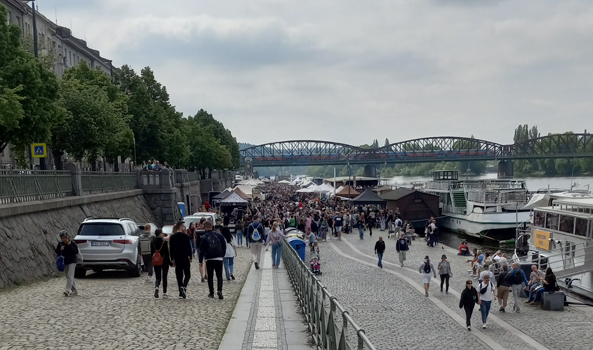 |
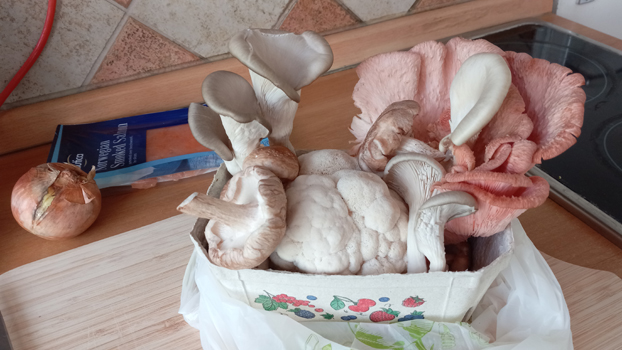 |
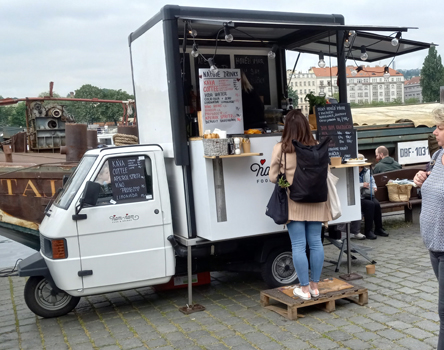 |
|
Naplavka Market |
Mushroom box |
Mobile Coffee vendor |
Prague is bursting with live theatre. Dozens of divadlo (theatres) fit in where a large enough space
is available, including our building. Because of all the tourists and the large, vibrant English expat
community, there are plenty of plays in English, and supertitles for some of those in Czech. We went to
see The Cherry Man (in Czech), at the historic Estates Theatre, a grand opera house from the 1700s, where
Mozart himself released and personally conducted his 25th symphony. The Cherry Man is a new, dystopian
play of egregious Roman style excess, amorality and debauchery. Basicaly the decline and fall of humanity ending
from climate change. Unexpected Prague.
 |
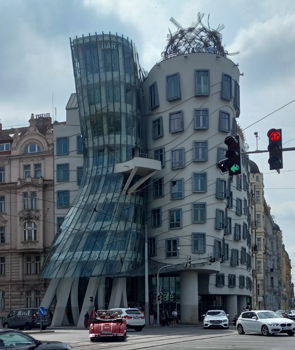 |
|
Estates Theatre |
Gehry Dancing Buildings |
Not to be missed, of course, is the huge complex of castles and churches at Hradcany, on top of the hill
across the Vitava River, overlooking Stare Mesto. Easily defensible, it just grew into a royal city of civil
servants, formal and informal gardens, and endless restaurants.
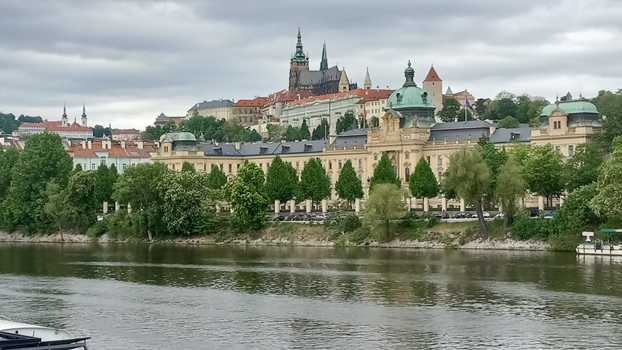 |
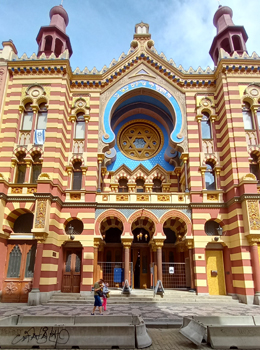 |
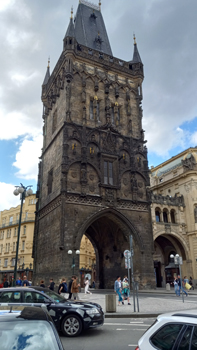 |
|
Hradcany |
Art Nouveau Synagogue |
Powder Gate |
The world-famous Wenceslas Square is a half-mile long shopping mall now. It is lined with department stores
like C&A, Primark, and Marks & Spenser, but also cheesy souvenir shops, and sadly, a huge McDonalds at both
ends. It also has a famous beer house called Vytopna, where an expansive model train set delivers your order
right to your table. A tourist trap like no other. An awful lot of history happened in Wenceslas Square, but
as it was mostly bloody, perhaps intense tourism is a good way for it to end up.
And the tourism is intense. We were surprised at how many parents take their children out of school to visit
here weekdays. And local high schools provide endless guided tours, competing with all the other tourist walking
tours choking the streets. All of retail is at least bilingual with English, freely and well spoken. In the outer
areas it is much less so, so my rudimentary Czech came in handy from time to time. People were always very helpful,
and everyone says Good day, Dobry den, to everyone they encounter, all day long.
